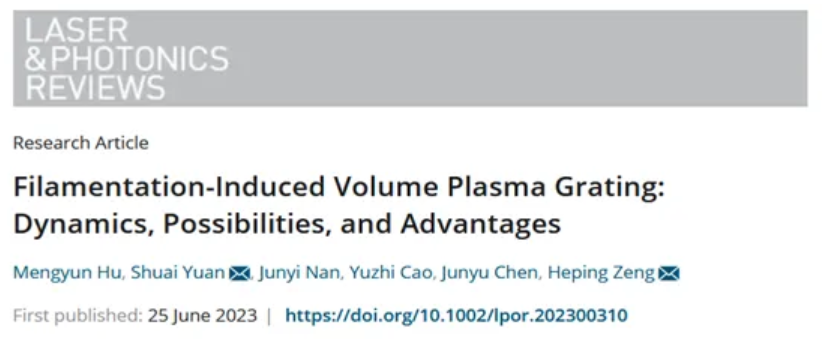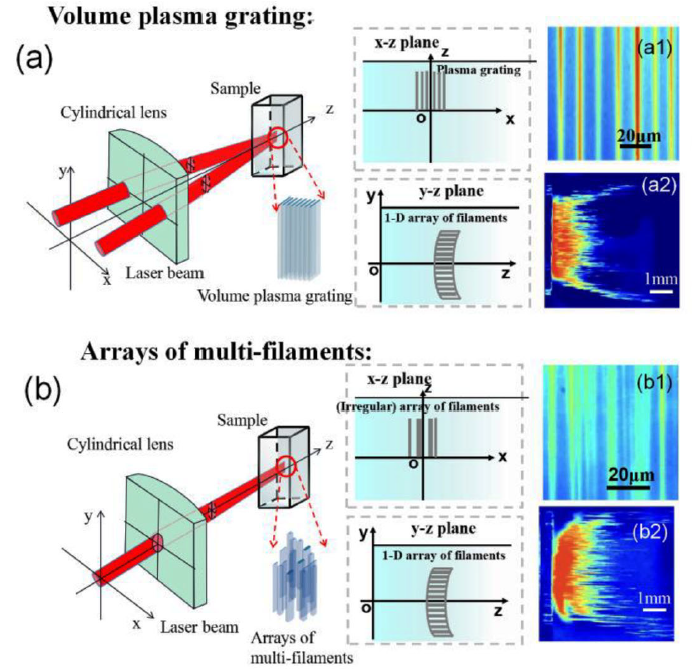Recently, the Chongqing Research Institute of East China Normal University, in collaboration with Shanghai University of Technology and East China Normal University, proposed the concept of "Volume Plasma Grating" for the first time. The volume plasma grating is composed of periodic layered plasma generated by the interaction of two one-dimensional arrays of multiple filaments. This achievement was published in Laser&Photonics Reviews on June 25, 2023, under the title of "Filamentation induced volume plasma graphing: Dynamics, Possibilities, and Advantages".

Femtosecond laser filamentation is a unique phenomenon of ultrafast laser propagation in a medium. For air media, when the peak power of the laser is higher than self focusing, the self focusing caused by Kerr effect and the self defocusing effect caused by plasma generation should reach a dynamic equilibrium. The filament process includes multiphoton ionization, inverse bremsstrahlung, and avalanche ionization, resulting in the generation of iconic plasma channels. However, when the incident power far exceeds the critical level, multi filament phenomenon may occur.
Due to the instability of pulse modulation, the generation of multiple wires is a random process. Any hot spot in the initial beam spatial pattern will lead to a random distribution of the light field space. Because of this, researchers have suppressed the production of multiple filaments through various means. The starting point of our research is how to ensure that randomly distributed filaments propagate in a predictable manner. This study has significant implications for radar remote sensing, air laser, and high-end manufacturing related to fiber optics.
The Chongqing Research Institute of East China Normal University, in collaboration with Shanghai University of Technology and East China Normal University, has found that two non collinear propagating filaments can generate plasma gratings in air, water, and glass through interaction. Plasma gratings can break through the peak power confinement inside the fiber and construct a stronger optical field. Unlike previous reports on planar plasma gratings, this paper proposes an innovative volume plasma grating. The volume plasma grating is formed by two one-dimensional multi filament arrays through a similar interference effect. Volume plasma gratings can achieve periodic and regular distribution of light fields, thereby overcoming the randomness of multi filament distribution.

Figure 1: Schematic diagram of (a) volume plasma grating and (b) multi wire array. The excitation beam propagates on the z-x plane.
The side views of the volume plasma grating and the multi wire array in the y-z plane are shown in Figure 1, respectively. The multi filament array at the focal point is distributed in a crescent shape. Any modulation instability process in the dynamic balance between self focusing and plasma self defocusing during the formation of multi filaments by a single beam of light can alter the instantaneous energy competition state between the multi filaments, resulting in random changes in the cross-sectional light intensity of the filaments. Meanwhile, the diameter of microplasma channels is uneven. The distance between adjacent channels in the experiment decreases with the increase of excitation energy. On the contrary, inside the volume plasma grating, the distribution of microplasma channels is uniform and there are no randomly distributed hotspots. This indicates that the volume plasma grating structure can suppress the random distribution of multiple filaments.
Based on the above research, we have gained a further understanding of multi wire arrays and volume plasma gratings. The optical field inside the multi wire array is affected by modulation instability, and the structure is randomly distributed. The volume plasma grating is composed of regularly distributed plasma channels. The formation of microplasma channels in a multi wire array is related to local energy fluctuations on the medium, with irregular distribution. The volume plasma grating is generated by the non collinear spatiotemporal coupling of two multi filament arrays, resulting in a stable distribution of multi filaments.
Volume plasma gratings can guide light beams through regularly distributed plasma waveguides through spatial reconstruction of electric fields. During the interaction between the volume plasma grating and the sample, the spatially stretched volume plasma grating is periodically modified by laser to change the refractive index of the material at the cross-section of the beam. In this sense, the stable internal structure of the volume plasma grating is caused by the generated periodic plasma waveguide "presetting" the propagation trajectory on the beam cross-section. Therefore, the optical fibers inside the volume plasma grating have a more stable optical field distribution compared to the multiple fibers in a single optical fiber array.

Figure 2: (a-d) Preparation process of terahertz polarizer based on volume plasma grating, (e) Schematic diagram of terahertz polarizer testing optical path.
(f) Terahertz time-domain curves at different angles.
Existing experiments have shown that volume plasmon gratings can be used for rapid direct writing of three-dimensional structures, as well as for the preparation of terahertz polarization elements. As shown in Figure 2, in the experiment, we used a volume plasma grating for laser direct writing on glass, and then obtained periodic groove lines through acid washing. Then, we successfully obtained terahertz polarizers by coating with conductive silver glue. Its function can be compared to commercial terahertz polarizers.
Compared with traditional multi filament control methods, volume plasma gratings convert energy spatial random distribution (multi filament) into periodic regular distribution through preset propagation trajectories.
It has the following advantages:
1) The period of the light filament in a spatially stretched volume plasma grating can be adjusted by changing the cross angle of the excitation beam, making it more convenient to adjust the period;
2) Compared to traditional femtosecond laser direct writing, laser direct writing based on volume plasma gratings has higher efficiency;
3) The volume plasma grating actually guides energy into the periodic plasma channel, which does not cause additional loss of incident light energy. Therefore, based on this, fast direct writing of three-dimensional structures and preparation of terahertz polarization elements can be achieved.
This work has received joint funding from the Ministry of Science and Technology, the National Natural Science Foundation, the Shanghai Municipal Science and Technology Commission, the Chongqing Science and Technology Bureau, and the Liangjiang New Area.
Source:华东师大重庆研究院科研团队在飞秒激光成丝诱导体积等离子体光栅的研究中得重大突破
Link to the paper:https://doi.org/10.1002/lpor.202300310
